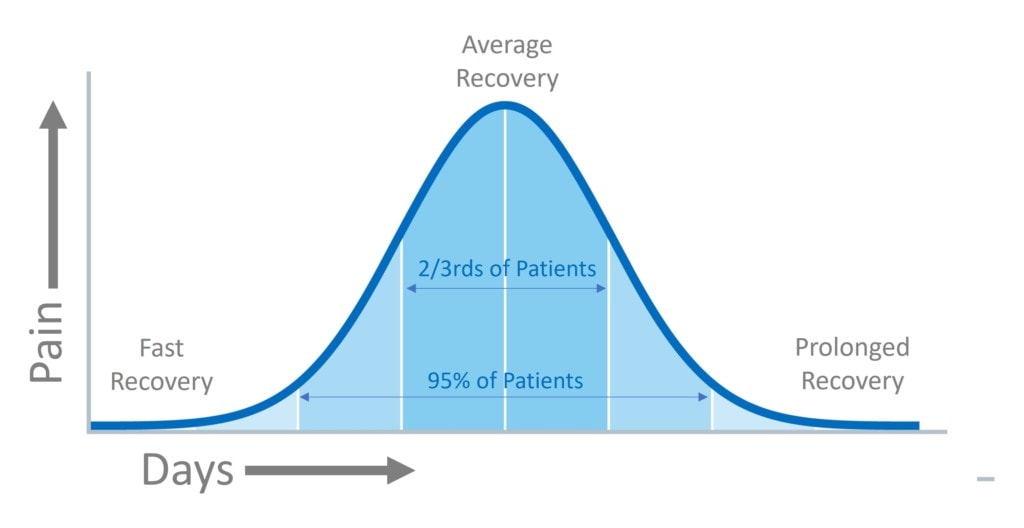What Does the Length of Recovery after Orthobiologics Say About Your Condition?

One of the things that is critical to understand for any patient getting an Orthobiologic procedure is how fast you recover usually tells us something about your medical condition. In particular, patients that enter into a prolonged recovery may have more issues that spell trouble long-term. Hence, let’s dive into that issue this morning.
The Bell Curve
If you’re familiar with the idea of a bell curve (as shown above), most people will fall into the bulk of the curve. In math, this is within two standard deviations from the mean. In fact, 95% of us will live there. Hence, if we draw a bell curve of recovery for patients undergoing PRP or Bone Marrow Concentrate procedures, it would have post-procedural pain along the vertical Y-axis and the number of days for recovery along the horizontal X-axis.
The Bell Curve and Procedural Recovery
After the typical PRP or BMC procedure, my instructions to patients are that they will be sore for 3-7 days. When I say that, I’m referring to the 2/3rds of patients who are 1 standard deviation from the mean. Then we have another 1/4 of patients who will take shorter or longer to recover. Meaning some of these 2 standard deviation patients won’t feel anything past 1-2 days on the quick recovery side and will be sore or flared up for two weeks on the slow recovery part of the bell curve. Then we have the tails on either end of the curve. These patients who are three SDs out on the one side of the curve won’t feel anything at all or very little from the procedure and those on the other will take a month or more to recover. These represent about 5% of patients.
Different Procedures Have Different Recovery Times
While the 3-7 days is typical for most PRP and BMC procedures, there are procedures that require less or more recovery time. For example, LP-PRP (leukocyte poor or amber platelet rich plasma) which is what we usually use has a shorter recovery time. LR-PRP (red PRP), tends to have a longer recovery time. BMC is slightly longer than LR-PRP.
The number of structures injected and in which patient population also matters. For example, a simple intra-articular (inside the joint) LP-PRP injection has a shorter recovery time, but on the other end of that spectrum would be a knee where many ligaments, tendons, and several bone sites were injected with BMC which would generally take longer to recover. Also, treating patients with the average orthopedic injury requires less recovery, but treating car accident patients with chronic pain may require longer recovery times.
If You’re At the Tail End for Prolonged Recovery, What Does This Mean?
There are a couple of options:
- The procedure was more aggressive than average
- Your inflammatory response is more aggressive
- Your central nervous system is sensitized
Let’s go over all three:
The Procedure Was More Aggressive than Average
It’s certainly possible that due to the nature of your procedure, the doctor had to get more aggressive with the tissue. This can sometimes happen in tendon injuries where more fenestration is needed (poking more holes in the tendon) because of larger tears.
Your Inflammatory Response Is More Aggressive
If you have high systemic inflammation, then this can act like dry kindling and a campfire. In that analogy, it’s easier for the whole forest to catch on fire and burn longer than just the campfire. The number one cause of this is Metabolic Syndrome. Carrying extra weight in middle age and beyond combined with high blood pressure, insulin resistance, and other factors can cause your body’s level of systemic inflammation to be high. One way to help is to aggressively take anti-inflammatory supplements and switch to a low sugar diet while losing the extra weight. Your doctor may also choose to use low-dose anti-inflammatories after the procedure to help you get over this excessive inflammation hump.
Your Central Nervous System is Sensitized
For people with chronic longstanding pain or who have been in a car crash with high pain levels since, the nervous system that carries pain signals can become way too good at its job, leading to something called Central Sensitization. This means that small amounts of stimulus produce a HUGE and abnormal pain response. This can also cause prolonged pain after a procedure. One way to help this is to use medications that can reduce this nerve sensitization like Lyrica. Another way to limit this type of flare is to only get procedures done while completely anesthetized.
The upshot? If you have a prolonged recovery, it’s a great opportunity to learn additional information about your overall health. Speak with your doctor about what you can do to help recover more quickly in the future.
If you have questions or comments about this blog post, please email us at [email protected]
NOTE: This blog post provides general information to help the reader better understand regenerative medicine, musculoskeletal health, and related subjects. All content provided in this blog, website, or any linked materials, including text, graphics, images, patient profiles, outcomes, and information, are not intended and should not be considered or used as a substitute for medical advice, diagnosis, or treatment. Please always consult with a professional and certified healthcare provider to discuss if a treatment is right for you.